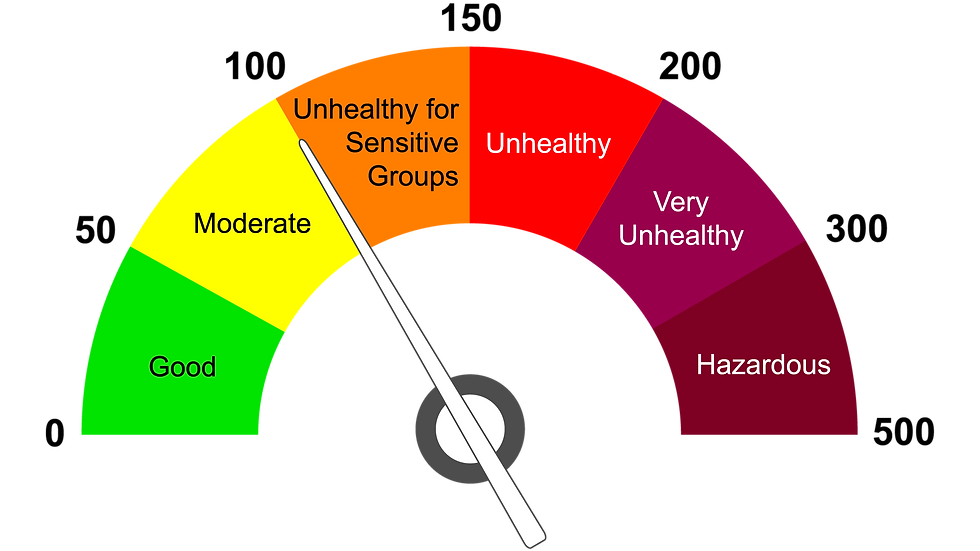Does Spring Mean a good AQI?
- uBreathe
- Sep 7, 2024
- 3 min read
Generally, air quality is not directly referred to through the concentration of environmental pollutants but through AQI (air quality index). AQI is better and more holistic than citing the concentration of only one-sized particulate matter. AQI is an index that summarizes the status of air quality daily. It could be local, outdoor, and indoor in the environment in which it is evaluated.
Although AQI depends on many factors, in general, spring can bring improved AQI values compared to winter in many regions. This is because:
Warmer temperatures in spring allow the air to circulate better, helping to disperse pollutants that build up during winter inversions.
Rain showers in spring help to wash away particulate matter from the air. Ozone levels often increase in spring, especially in urban areas with more sunlight and warmer temperatures creating ground-level ozone.
However, High pollen levels in spring from blooming plants can decrease air quality for those with pollen allergies. Agricultural activities like tilling fields can stir up dust and particulates early in the growing season.
Apart from that, in cities like Gurgaon, Faridabad, Noida, and Delhi, AQI remains at a significantly high level throughout the year because of the industries in these areas.
Notably, the current PM2.5 concentration in New Delhi is 8.3 times above the recommended limit set by the World Health Organization (WHO) 24-hour air quality guidelines. This high PM2.5 pollution has been estimated to cause approximately 25,000 deaths since January 1, 2021, and has cost the city’s economy around US $3.7 billion so far this year.
This points to the fact that spring brings a considerably better AQI in comparison to the AQI in Winter. However, considering the location of some cities, even spring doesn't bring a notable change.
What is the solution?
While outdoor air pollution levels may be beyond an individual's control, there are steps we can take to prevent and reduce indoor air pollution at home or in our workplaces.
Invest in uBreathe air purifier
If you're allergic to indoor allergens and can't control the source of the problem — for example, you're unwilling to give up your family pet — it may help to use an air purifier. uBreathe is one such air purifier for individuals with allergies or asthma, uBreathe air purifiers help reduce the presence of allergens and irritants in the air, potentially alleviating symptoms and improving breathing. Not only that, but uBreathe ensures sustainability and comes with a plant that makes it stand out.

Air Quality Monitor
An air quality monitor can help you keep track of the levels of various pollutants in your workspace. These devices measure particulate matter, volatile organic compounds (VOCs), humidity, and temperature.
uBreathe air monitoring includes Real-time air quality monitoring via IoT sensors and a user-friendly dashboard. Monitoring also undertakes "Ongoing support" for equipment maintenance and air quality management.
Ventilation System
To avoid a suffocating environment, it's very important to ensure that there's a proper flow of air at your place. uBreathe Vent is a sophisticated ventilation system that pulls in fresh, filtered outside air to promote healthy indoor air quality. ubreathe vent creates a constant air exchange following the ASHRAE standards, which reduces the buildup of harmful pollutants and allergens and reduces the risk of respiratory illnesses.

Clean Home = Healthy Home
A clean house may be a healthier house because good indoor hygiene can greatly cut down on dust and animal dander. So, make sure to keep your house clean.
Reduce dampness
Dampness in indoor spaces can lead to many health hazards, including mold growth. Dampness and high humidity may also cause VOCs to leach into your air.
Use indoor plants
Houseplants not only add a touch of nature to your workspace but also help in improving indoor air quality. Plants like the snake plant, spider plant, and peace lily are known for their air-purifying qualities. They absorb toxins and release oxygen, making your workspace healthier and more pleasant. While plants may not have the brawn of industrial machines, there are some that NASA recommends for clearing out the toxins in your air. These plants include Snake Plant, Peace Lily, Bamboo Palm, Parlor Palm, etc.

By integrating uBreathe into your home workspace, you can breathe easy knowing that you are investing in a healthier, cleaner, and more productive environment. Choose uBreathe for the ultimate in indoor air quality and experience the difference today!


Comments